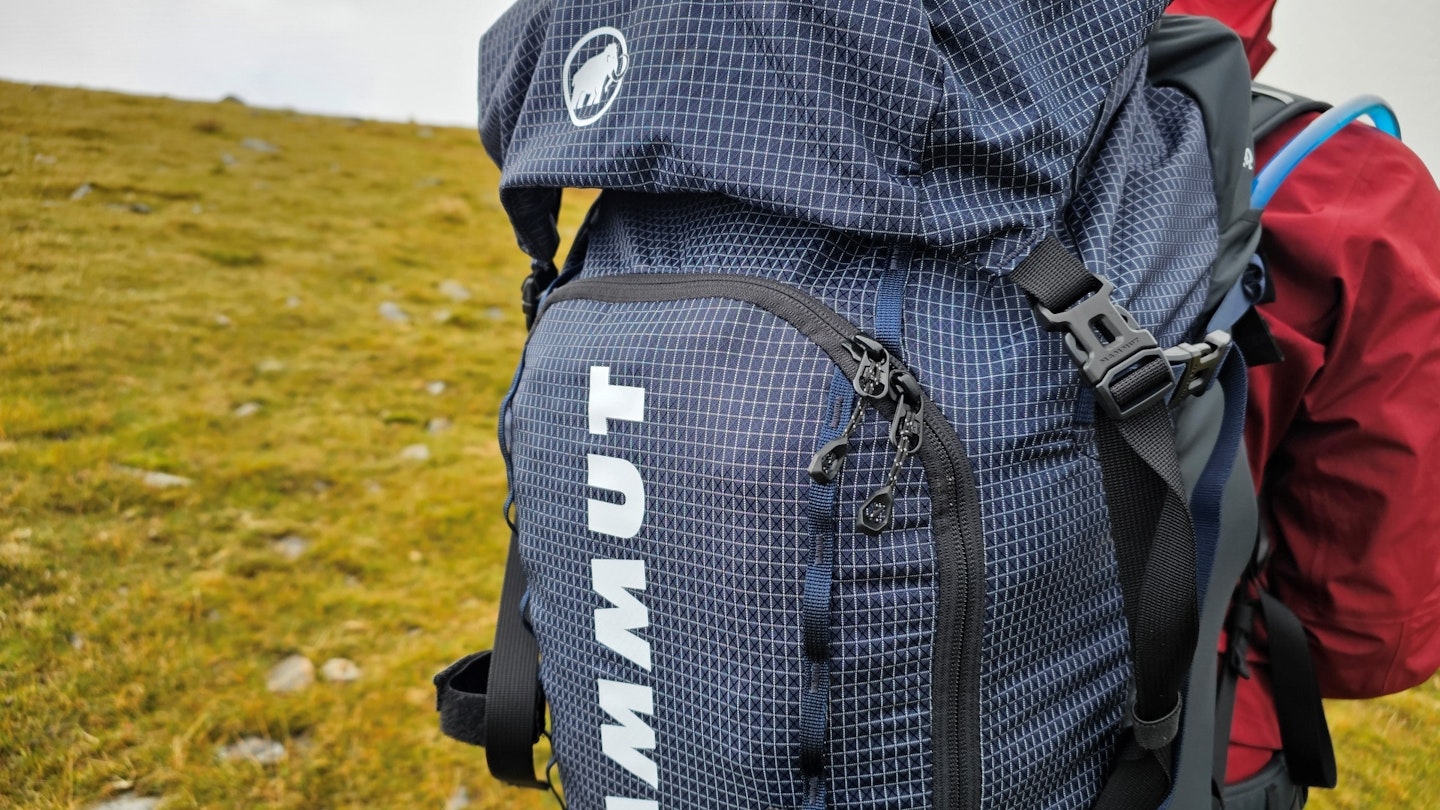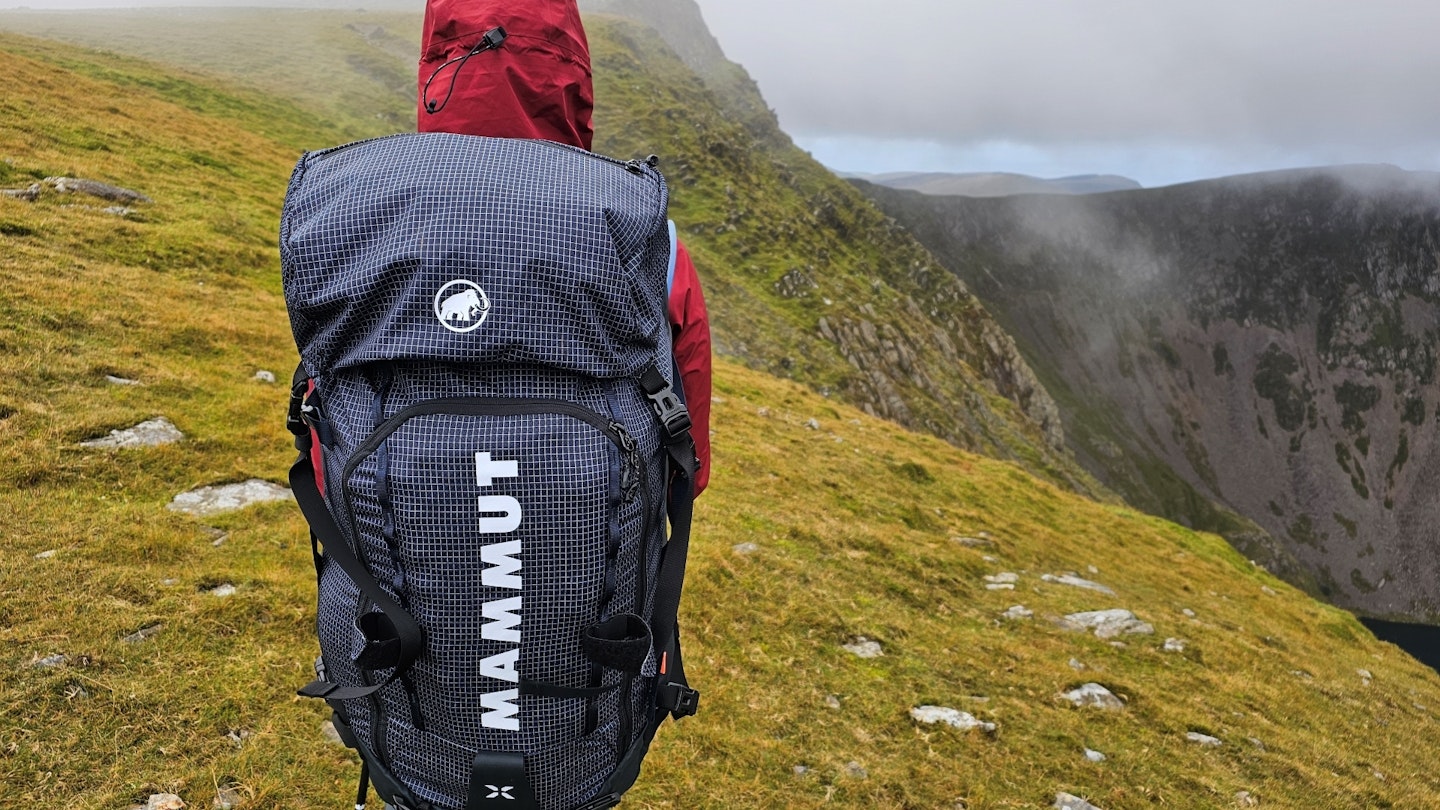If you're looking for a great winter pack then the Mammut Trion 50 has to be in your reckoning, says Matt Jones. Here's why...
We’re big fans of Swiss brand Mammut’s packs. From the excellent Lithium series of hiking packs to the light and fast Ducan series, all have impressed us on test with their load-carrying ability and slew of innovative features.
The more technical Trion range is no exception – the deluxe Trion Spine 50 (with its pivoting lumbar frame) and the previous generation of the simpler and lighter Trion 50 have both been previous Trail ‘best in test’ winners.
However, Mammut has redesigned the Trion 50 for 2024, with a new look, a more streamlined feature set and, for the first time, a dedicated women’s version. Has one of our favourite all-round mountain packs just got even better? I took it into the mountains of Snowdonia to find out.
Pros
- Tough and weatherproof
- Practical and versatile
- Secondary access to main compartment
- Women’s version available
Cons
- Not the lightest
| RRP: | £190 / $199.95 |
| Volume: | 50L |
| Sizes: | o/s (men’s and women’s options available) |
| Materials: | Main body 90% nylon, 10% polyester (partly recycled), base and side panels 100% nylon |
| Weight: | 1.51kg (3 lbs 5 oz) |
Design and features
Mammut describes the Trion 50 as “the ideal partner for climbing, ski tours, and mountaineering”. It's a little wider than most pure alpine packs, which means it doesn’t have as slim a silhouette as some rivals.
But on the other hand, this ensures it can swallow plenty of kit, including bulky items like camping or bivvying gear if necessary.
It's a top-loading pack with a floating, double-buckle lid. Underneath the lid, there’s a zippered roll-top closure that gives access to the large main compartment. This offers excellent weather protection and security.
Inside, there’s a sleeve for a hydration reservoir and an exit port for a drinking tube on the right shoulder. A hidden rope strap tucks neatly out of the way but gives you the ability to secure a climbing rope or other kit under the lid.
Dual webbing straps on either side of the pack are all fitted with quick-release buckles, so they work well for carrying extra kit as well as side compression. Tough webbing loops at the base of the pack are intended as A-frame carry for skis.
The front panel has extended daisy chain webbing and multiple attachment points for trekking poles or ice axes, with a central pick guard. You also get a large zippered front pocket with internal organisation.
Flip the pack over and the back panel also reveals a large, U-shaped zipper, which gives quick access to the main body. This was one of our favourite features of the previous model, so we’re pleased to see it has been retained.
It’s a bit of a gamechanger for grabbing extra layers fast – always good when you’re out in winter conditions.
Harness and back system

The pack has a U-shaped internal wire frame for rigidity, with a lightly padded back panel. This is now overlaid with tougher fabric rather than mesh, which resists abrasion better and also absorbs less moisture.
It’s a simple but effective system, though the flat panel isn’t contoured to follow natural back curvature like some packs. This means it doesn’t hug the body quite as well.
The back length is fixed but this pack does now come in both men’s and women’s versions (18” and 16” torso lengths respectively), which are ergonomically designed to suit different anatomies.
This includes the harness, which has differential shoulder straps cut to suit male or female frames. Both are still fitted with load lifters, though the chest strap has been replaced with flimsy elasticated cord.
The men’s version has expanding mesh pockets on each strap, which are absent from the women’s model, being replaced with a narrower and more breathable fabric.
Hip fins are more forgiving than the previous model, and fully removable if you don’t want them getting in the way of a climbing harness.
The previous generation of the Trion 50 had a zippered pocket on one hip fin and a gear loop on the other, but these have now been removed. This saves a little weight but is still a backwards step in my opinion, since I appreciated having the pocket for more general hillwalking or backpacking use.
Pockets and storage

Luckily, the Trion 50 retains plenty of practical storage. I particularly like the rear access to the main compartment, as well as the mesh storage pocket located inside the main body of the pack.
That big front pocket is also useful – it’s designed for stashing avalanche equipment like a probe and shovel, but for UK winter use it also works well for storing crampons. Outside of winter it’s a great place to keep a spare warm layer or waterproofs.
The lid now has both outer and inner lid pockets, whereas the old Trion 50 only had an outer pocket. And while they’re not as roomy as some, you can still stuff a pair of winter gloves and a map in there.
Performance and comfort

On test, we found this a comfortable pack to carry. The harness isn’t the plushest, but it's nicely contoured so as not to dig in, and the internal frame provides decent load transfer. And while I'd prefer a moulded, sculpted back panel to the Trion 50’s simple shoulder and lumbar pads, they still do the job.
It also proved a capable, versatile and practical mountain companion. It’s a tough and weatherproof pack, and the addition of a zippered rolltop closure rather than a standard drawcord collar is a definite plus. As well as keeping your kit safe and dry, it also allows you to overstuff the pack if needed without sacrificing weather protection.
However, our favourite features are the handy zippered front pocket and that U-shaped zip around the back panel, which means you can open out the rear of the pack to access the main body easily.
Both these elements are supremely practical, making life on the hill so much easier. In fact, having experienced them, we’d now be loath to carry a pack into the mountains that lacked these features.
Sustainability
The main body of the Trion 50 is made from a 90/10 mix of nylon and polyester, with a nylon base and side panels. All these fabrics contain recycled fibres, though Mammut doesn’t specify the fabric weights or exactly what percentage is recycled.
However, fabrics are bluesign-approved (a sustainable textile certification that eliminates the use of harmful substances and guarantees a responsible use of resources with a minimum impact on people and the environment).
As such, the product is also Fair Wear certified and finished with a PFC-free durable water repellent treatment.
Price and competition

With a RRP of £190 ($199.95), this isn’t a cheap pack, though it costs slightly less than comparable rivals like the Berghaus MTN Guide 45, the Mountain Equipment Fang 42+ or the Gregory Alpinisto 50.
You do get a lot for your money, with a couple of excellent features that are unique to this pack. It’s also one of the only technical mountain packs of this size on the market that comes in a dedicated women’s-specific fit.
So, in terms of overall functionality and practicality for the widest range of users, it’s my pick of the bunch in the 40-50L winter packs category. Plus, it feels tough and well-built, so I'd expect good lifetime durability.
But if you want to save bit of cash and are prepared to forgo a few features, we’d recommend looking at either the Rab Ascendor 45:50 or the Alpkit Orion 45.
Alternatively, if you’re prepared to spend a bit more for superior carrying comfort (especially with heavier loads), then consider the Gregory Alpinisto 50.
Verdict
The Mammut Trion 50 is a tough, versatile all-round mountain pack that carries well under load, swallows plenty of kit and has some very practical features for winter use.
See our list of the best hiking backpacks for wider choice of options.
Shop this product
About the author

Matt Jones is a freelance journalist based in the heart of Snowdonia National Park, he’s a vastly experienced gear tester and self-confessed outdoor kit geek. Matt’s been one of our main gear testers for the last couple of years and is the first person we call with any complicated kit queries that need in-depth and forensic analysis.






